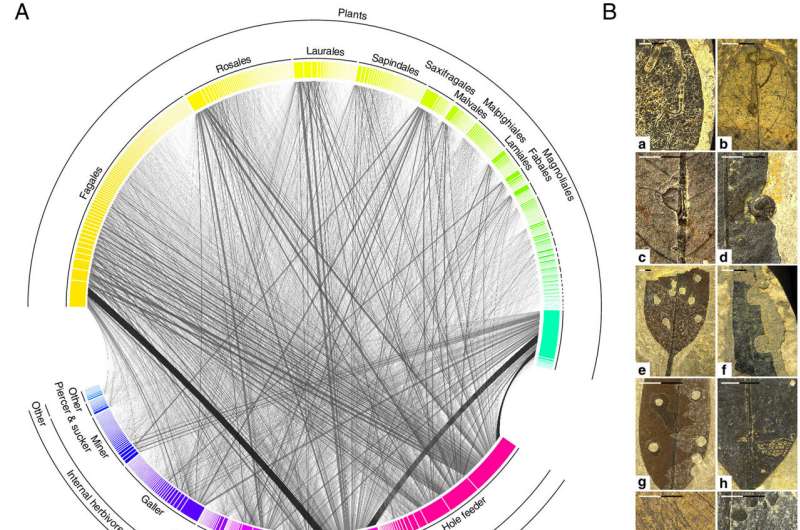This article has been reviewed according to Science X's editorial process and policies. Editors have highlighted the following attributes while ensuring the content's credibility:
fact-checked
peer-reviewed publication
trusted source
proofread
Feeding traces on fossil leaves help researchers identify factors leading to enormous herbivore diversity

Researchers from the Hessian State Museum Darmstadt and the Senckenberg Biodiversity and Climate Research Center Frankfurt have uncovered the factors that determine the enormous diversity of herbivorous insects.
In their study, published in the journal PNAS, they show that the diversity of herbivorous insects evolved over the last 60 million years primarily through the shared use of food plants. The results are based on the analysis of feeding traces left by arthropods on more than 45,000 fossil leaves.
Herbivorous insects are the most diverse group of multicellular organisms on Earth. The variety of their mouthparts and feeding modes also testify to a high degree of diversity: for example, there are caterpillars or beetles that chew on leaves with their powerful jaw-like mouthparts, bugs and aphids that pierce plants to get at their sap, or animals that stimulate plants to form galls—an excessive tissue growth—in which they can develop and feed protected from enemies.
"The feeding traces of such insects are also clearly visible on fossil leaves. They can help us to identify the factors that led to the enormous diversity of herbivorous insects," explains Dr. Jörg Albrecht from the Senckenberg Biodiversity and Climate Research Center in Frankfurt.
Albrecht, together with Prof. Dr. Torsten Wappler of the Hessian State Museum in Darmstadt and other Senckenberg researchers, classified a total of 47,064 fossil leaves of 436 plant species from 16 sites in Central Europe, Iceland, and Norway and examined them for feeding traces left by insects.

"The fossils we studied cover nearly the entire Cenozoic era, i.e., the period between 66 and two million years before present. Moreover, the fossilized leaves originate from a variety of climates—from subtropical to oceanic to humid continental," explains Wappler.
The team of researchers examined each well-preserved fossil leaf for signs of feeding by insects. More than one-fifth of the studied leaves revealed corresponding traces.
"Based on these data, we can show that food plants were already used by a variety of herbivorous insects in early geological history. Moreover, the detailed evaluation of the feeding traces shows that the shared use of a plant species by different groups of herbivorous insects contributed twice as much to their functional diversity—in terms of their feeding mode—as the species diversity of the food plants themselves," says Albrecht.
The results thus provide new insights into the origin of insect diversity and show that the co-occurrence of many specialized insect species on the same plant species is the primary factor driving the functional diversity of herbivorous insects, according to the authors.
Albrecht adds, "When different insect species share a food plant species, they also have to adapt their diet and feeding mode to avoid direct competition with each other. Over millions of years, this led to the emergence of an incredible diversity of mouthparts, and ultimately species." The study's findings are reflected in today's tropical forests, where most herbivorous insect species specialize on specific plant families, which in turn provide food for a variety of insect species.
"Our study emphasizes that the fossil record can be used to test fundamental theories about the origin of biodiversity. The results of our study are also an important benchmark for identifying the factors that determine the diversity of herbivorous insects in contemporary ecosystems," concludes Wappler.
More information: Jörg Albrecht et al, Fossil leaves reveal drivers of herbivore functional diversity during the Cenozoic, Proceedings of the National Academy of Sciences (2023). DOI: 10.1073/pnas.2300514120
Journal information: Proceedings of the National Academy of Sciences





















